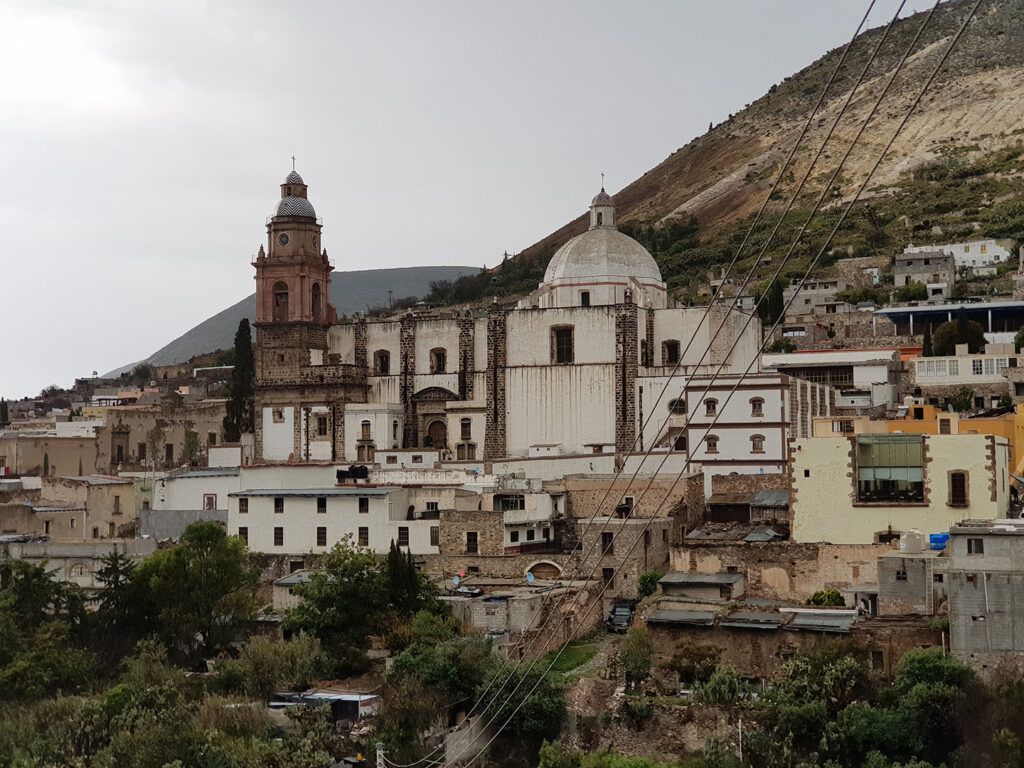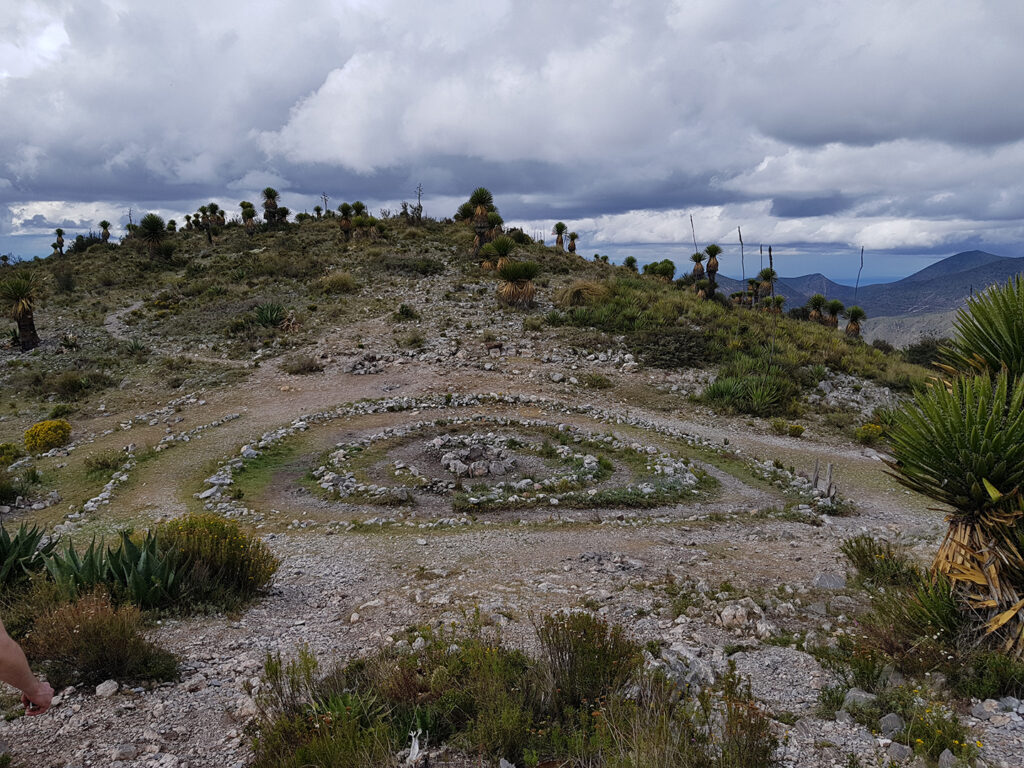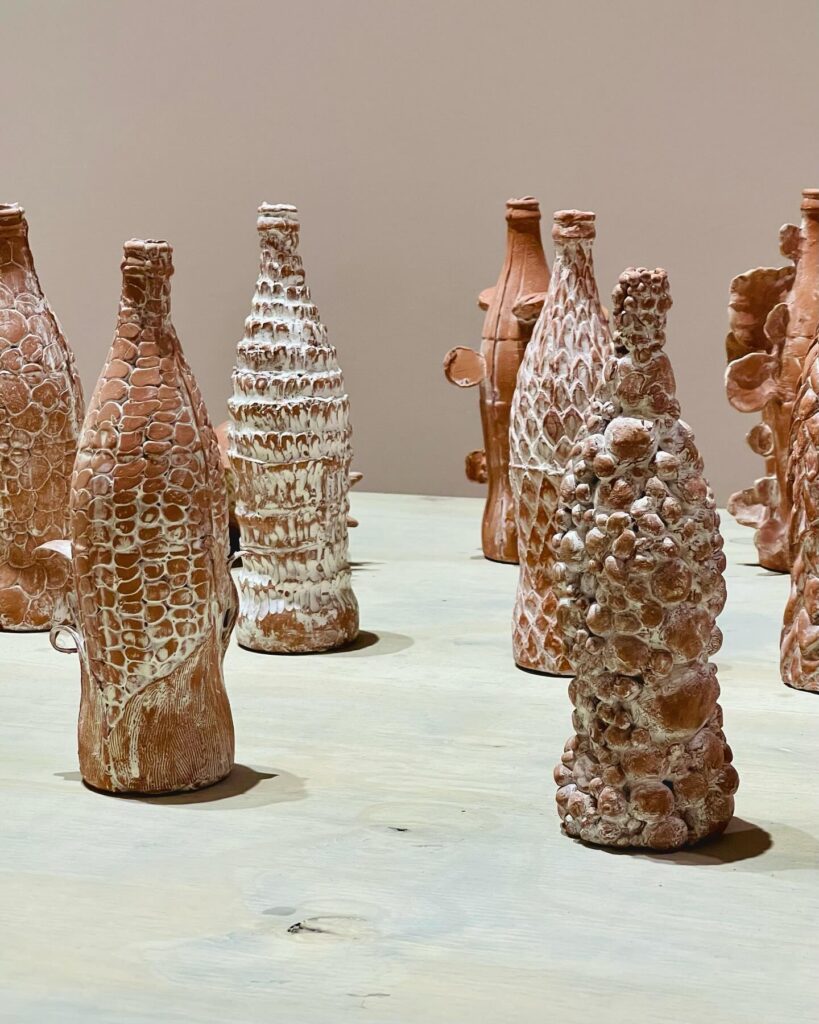We drive out of Monterrey, west first, then south, skirting around the mountains. Two hours later, highways become desert roads. Another two hours pass; the desert roads become a dirt track. Before long, more mountains loom into view. We come to a stop near a tunnel that’s cut through one of them.
Guards beckon us to wait while cars from the other end of the tunnel drive out. Then it’s our turn to drive in. After a few minutes of radio static, a town opens up before us. Like Monterrey, it’s encircled by mountains. Square stone buildings line pebbled streets. A cupola-capped cathedral marks the middle of the town.
The whole town’s electricity is out. We edge along a cliff and find our hotel in the headlights, light some candles, and use our phone torches to check for spiders and scorpions.

The next day, I’m feeling a little lightheaded. I’ve lived most of my life at sea level, and this place is nearly 3,000 metres up. But I get some protein in me (some grasshoppers a man was selling in little plastic bags) and feel better in no time.
We press on with our plans: ride horses up a mountain to overlook the sacred site where the Wixárika, an indigenous people, believe the world was created and the sun was born. Another thousand metres won’t hurt, right?

In the years since our visit, tourism in this mountainside town has grown rapidly — much of it from folks seeking the hallucinogenic effects of a magical cactus, so much so that the peyote has become a protected plant. We saw the beginnings of this catering to international travellers: 4×4 tours, souvenir shops, and, most helpfully for us, horses for hire.
Pebble streets become dirt paths. Dirt paths become… nothing. We trot along, following the natural undulations of the land, for maybe half an hour. As we approach the foot of the mountain, a clearing with a circular stone hut comes into view. This is where we’ll tie up our horses before trekking up the mountain on foot.
I peer through the iron bars of the hut’s window. Pretty simple: a table, some chairs. There’s a refrigerator in the far corner (insomuch as circular buildings can really have ‘corners’). It’s the kind you might see in restaurants, with a glass door and, at the top, a buzzing, backlit sign. All the way out here, hours into the desert, at the bottom of the mountain where the sun was born: familiar calligraphy against neon red.
COLORADO, 2009. My second time setting foot in the United States (the first: a trip to Disney World in Florida when I was about six months old — I remember nothing). 15 years later, I’m back. My dad has met a woman online, and has flown here to marry her (runs in the family, apparently).
Not yet exhausted by the horrors of late-stage capitalism, I’m enamoured by the enormous souvenir shops, with their many weird flavours of sodas and sweets. In one, there’s a fridge full of assorted fizzy drinks. Mostly bottled in plastic, but there are some six-packs in glass bottles, too, packaged in little cardboard carry boxes. The cardboard boxes have a motif that reminds me of cartoons like Speedy Gonzales (my older self would come to know this tissue-paper décor as ‘papel picado’). Written beneath the omnipresent calligraphic logo is: ‘MEXICAN COKE’.
The story goes: Mexican Coke tastes better than Coke in the US, because gringo Coke is sweetened with high-fructose corn syrup, and Mexican Coke is sweetened with ‘real’ cane sugar.
I didn’t try Mexican Coke in 2009 (we already had enough luggage to cart around without a six-pack of glass bottles), but I heard about the corn syrup vs. cane sugar schism plenty of times in the ten years between Colorado and my first trip to Monterrey, so I was intrigued.
It did taste better, honestly. But! The placebo effect must have been at play, because Coke in the UK, it turns out, doesn’t use high-fructose corn syrup either. It probably tasted better because I was in high spirits after 1. meeting Kass and 2. landing in a country which gets more than 10 days of sunny weather every year. But when we went to the US on the other side of the pandemic, yeah, the difference was very distinct.
More striking than any contrasting flavours, though, was how deeply (and dangerously) Coke is integrated into Mexican culture. For me, in those early naïve days, seeing the Coca-Cola fridge in that remote desert hut was surreal. Now, it probably wouldn’t really surprise me.
Coke is so ubiquitous, if you go to a taco spot where you order drinks and then get them out of the fridge yourself, you wouldn’t say each brand (“one Coke, one Dr. Pepper”), or even “two soft drinks.” You’d say “dos cocas” — “two Cokes.” ‘Coca’ has just become the catch-all term, like ‘Google’, ‘Kleenex’, and ‘Jacuzzi’.
This is often true for water, too. Sometimes, water gets priced the same as soft drinks, so if you’re ordering two sodas and a bottle of water, you wouldn’t even need to specify “dos cocas y un agua” — nope, “tres cocas” would suffice.
Coke’s dominion over water goes beyond words, desert refrigerators, and (charmingly botched) hand-painted Coca-Cola logos on every corner. Many reports have highlighted how Coca-Cola’s overuse of groundwater has caused droughts, which forces people to either buy Coke, or the bottled water brands they own.
In some extreme (and quite dystopian) cases, this vicious circle has pushed the price of Coke a hair lower than the price of water.
When I got diagnosed with diabetes a couple years into living in México, I got pretty anxious for a while. I cut out all sugary drinks immediately, which, yeah, my discipline was commendable. But I also cut out almost every other carb and sugar overnight, to an unhealthy extreme. Fortunately, I got to a place of balance within a couple of months, and years later, I’m the healthiest I’ve ever been.
During that initial period of panic, I was at a party, chugging down water, when a stranger beside me who’s handing out beers from a cooler offers me one. I tell them, no thank you, I’m not drinking — I recently found out I’m diabetic (oversharing, in retrospect, but the diagnosis really had my whole self-perception in a chokehold). To my surprise, they laugh, say “same!” and point at some dark patches of skin on their neck (a skin condition associated with diabetes). They defiantly shake the one-litre Coke bottle they’re holding, then walk off.
I think that’s as good a representation of the Mexican sense of humour as anything: lovingly satirical, and unfazed by the bad hands life sometimes deals. When the Mexican government started putting octagonal warning seals on food (‘exceso calorías’ = ‘excess calories’, ‘exceso azúcares’ = ‘excess sugar’, etc.), they hoped it would motivate people to make healthier choices. All it took to totally reverse that ambition was a single TikTok from an American traveller in México who explained the idea behind the seals, but said they actually function like star ratings — the more seals there are, the better the snack. One viral video flipped the warning signs into seals of approval.
It’s a double-edged sword; humour can bring problems to our attention, but it can just as easily numb us to them. The nonchalance of that stranger gave me a much-needed reminder to go easier on myself. And I’ve learned a lot about socio-political and environmental issues in Latin America from borderline-nihilistic memes. But the beloved tradition of having a Coke with your tacos has, regardless of the health concerns and corporate corruption, won me over many times. And the sight of that Coke fridge all those miles into the desert, though quite sad on some level, was too bizarre not to laugh at.
One of my favourite places in Monterrey is MARCO, the Museo de Arte Contemporáneo (Museum of Contemporary Art). In early 2024, we visited to see ‘Pico y Elite’ (‘Corn and Industry’), a retrospective exhibition of Mexican artist Damián Ortega’s works from 30 years of his career. Sculptures, photography, textile pieces, and short films, curated around a narrative that explores the links between the importance of corn cultivation for 1. Mexican history and 2. industrial globalisation.
Among the most striking exhibits was ‘120 jornadas ceramica’, a collection of 120 ceramic sculptures representing everything from pre-Columbian fertility statues and Aztec/Mayan masks to cacti and, of course, corn, all shaped within a familiar silhouette: a Coca-Cola bottle.
